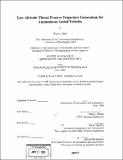Low altitude threat evasive trajectory generation for autonomous aerial vehicles
Author(s)
Pettit, Ryan L. (Ryan Louis), 1978-
DownloadFull printable version (11.83Mb)
Other Contributors
Massachusetts Institute of Technology. Dept. of Aeronautics and Astronautics.
Advisor
Mark L. Homer.
Terms of use
Metadata
Show full item recordAbstract
In recent years, high altitude unmanned aerial vehicles have been used to great success in combat operations, providing both reconnaissance as well as weapon launch platforms for time critical targets. Interest is now growing in extending autonomous vehicle operation to the low altitude regime. Because perfect threat knowledge can never be assumed in a dynamic environment, an algorithm capable of generating evasive trajectories in response to pop-up threats is required. Predetermination of contingency plans is precluded due to the enormity of possible scenarios; therefore, an on-line vehicle trajectory planner is desired in order to maximize vehicle survivability. This thesis presents a genetic algorithm based threat evasive response trajectory planner capable of explicitly leveraging terrain masking in minimizing threat exposure. The ability of genetic algorithms to easily incorporate line-of-sight effects, the inherent ability to trade off solution quality for reduced solution time, and the lack of off-line computation make them well suited for this application. The algorithm presented generates trajectories in three-dimensional space by commanding changes in velocity magnitude and orientation. A crossover process is introduced that links two parent trajectories while preserving their inertial qualities. Throughout the trajectory generation process vehicle maneuverability limits are imposed so that the resultant solutions remain dynamically feasible. (cont.) The genetic algorithm derived provides solutions over a fixed time horizon, and is implemented in a receding horizon fashion, thereby allowing evasion of threat areas of arbitrary size. Simulation results are presented demonstrating the algorithm response for a rotorcraft encountering several different threat scenarios designed to evaluate the effectiveness of the algorithm at minimizing risk to the vehicle.
Description
Thesis (S.M.)--Massachusetts Institute of Technology, Dept. of Aeronautics and Astronautics, 2004. Includes bibliographical references (p. 117-119).
Date issued
2004Department
Massachusetts Institute of Technology. Department of Aeronautics and AstronauticsPublisher
Massachusetts Institute of Technology
Keywords
Aeronautics and Astronautics.